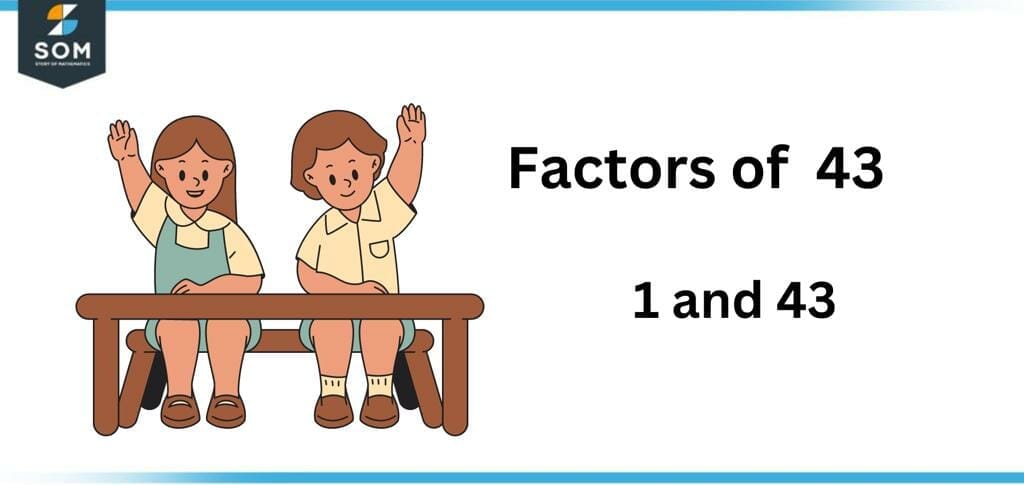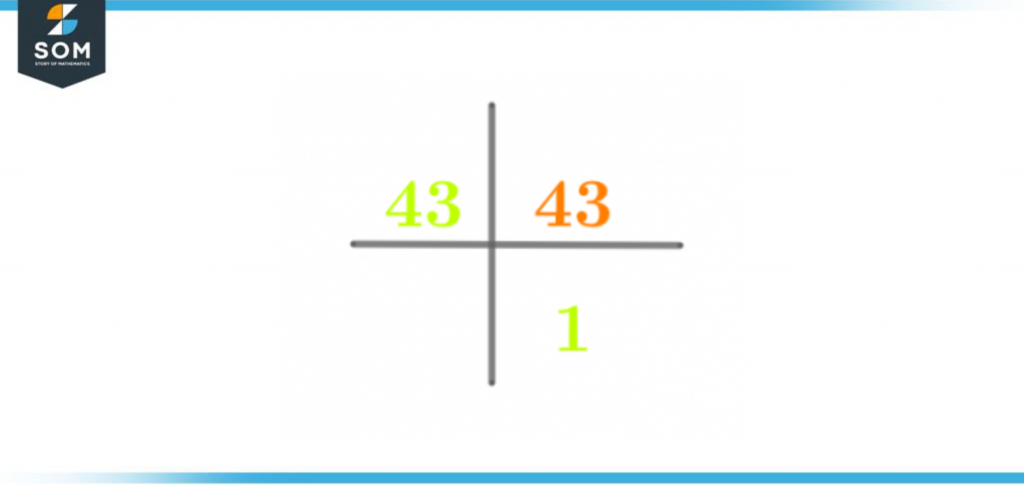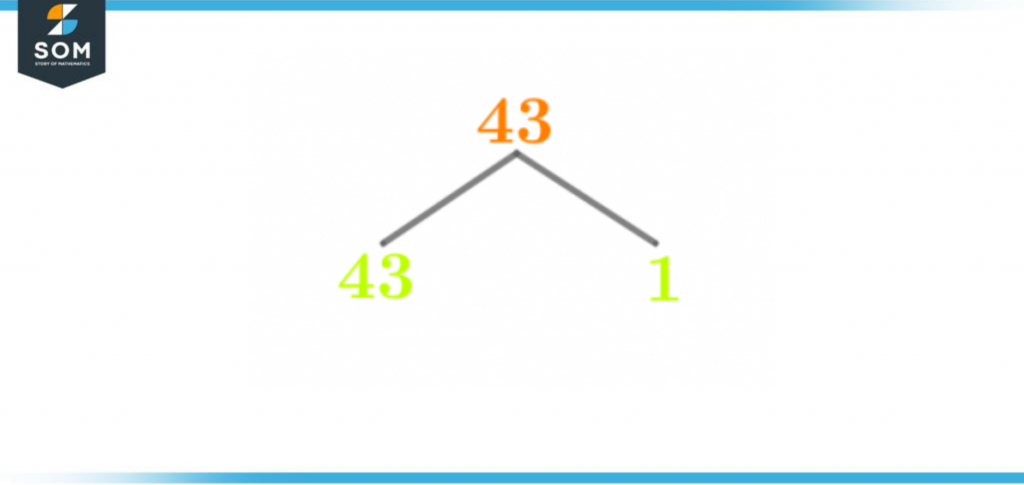JUMP TO TOPIC
Factors of 43: Prime Factorization, Methods, Tree, and Examples
The factors of 43 are the numbers that leave the remainder as zero and the quotient as a whole number when the number 43 acts as a dividend for such numbers. Such divisors act as the factors of 43.
Figure 1 – All possible Factors of 43
What Are the Factors of 43?
The factors of 43 are 1 and 43. Since 43 is a prime number, it only consists of 2 elements, which are also prime numbers. Prime numbers do not have any composite factors.The number 43 has only factors and these two factors can be grouped into a single factor pair.How To Calculate the Factors of 43?
You can calculate the factors of 43 by using the division method. The division method is the simplest and oldest method in mathematics used to determine a number’s factors. This method is very reliable and produces accurate results.Although the process of division may seem a little complex, the process involved in the division method is quite simple. This is because the division method comes with a condition. The condition of the division method is that if a zero remainder and a whole number as the quotient are produced as the result of the division, then and only then is the division considered valid. The divisor is qualified to be a “Factor.”The number 43 is a prime number, and the unique aspect of prime numbers is that they are only divisible by two numbers – the number one and the number itself. This is the reason why prime numbers have only two factors.Keeping this in mind, let’s move on to the division of the number 43 with its factors:\[ \frac{43}{1} = 43 \]As a result, the division produces a whole number as a quotient, and a zero remainder is obtained, indicating that number 1 is a factor of 43.Now, let’s move on to the other factors of 43. The division is shown below:\[ \frac{43}{43} = 1 \]Again, the conditions of the division method is met, so the number 43 qualifies as a factor.The factors of 43 are mentioned below:Factors of 43 = 1 and 43Besides being a prime number, 43 is also a natural number. This indicates that apart from positive factors, the natural number 43 will have negative integers as its factors. These negative factors are mentioned below:Negative Factors of 43 = -1 and -43Factors of 43 by Prime Factorization
The prime factorization technique is used to evaluate the prime factors of a number. In prime factorization, only the prime numbers can act as divisors. Prime factors are the prime numbers which are also factors of a number.In prime factorization, the number undergoes division. This division produces a quotient, a whole number indicating that further division is possible. The division is carried out with prime numbers only.The replacement of the dividend with the quotient keeps on occurring until only the number 1 remains in the end. In the end, the presence of the number 1 indicates that the prime factorization process is coming to a halt here.The prime factorization of the number 43 is shown below:43 $\div$ 43 = 1
As 43 is a prime number, its prime factorization will conclude after just one division step.So the prime factorization of the number 43 can be written as:Prime Factorization of 43 = 1 x 43
This prime factorization is also showcased in figure 2 given below:
Figure 2 – Prime Factorization of 43
Factor Tree of 43
The factor tree of the number 43 is a visual diagram with a tree-like structure used to determine a number’s prime factors. This tree consists of numbers and multiple branches.The factor tree starts with the number itself, giving birth to two branches. One of these branches will always hold a prime number, and the other branch will have a number susceptible to division.This division continues until only the prime numbers remain at the terminating branches.The factor tree for the number 43 is shown below:
Figure 3 – Factor Tree of 43
Factors of 43 in Pairs
The factors of a number are usually determined via the division operation. Still, these factors can also be evaluated via the multiplication operation—the factors determined via multiplication form a factor pair.A factor pair is a pair of numbers that are factors. The requirement for a factor pair is that these numbers must give the original number as the result when they are multiplied together.For instance, consider the multiplication given below:2 x 21 = 42
As the resulting number is not 43 after the multiplication, this means that 2 and 21 are not factors of 43, and they do not form a factor pair.The factors of 43 are given below:Factors of 43 = 1 and 43As the number 43 has only two factors, these two factors can form a single factor pair. This is given below:1 x 43 = 43
Factor Pair of 43 = (1, 43)As the number 43 has negative factors, this number can also have a negative factor pair. This negative factor pair will result from the multiplication of negative numbers as shown below:-1 x -43 = 43
Negative Factor Pair = (-1, -43)Factors of 43 Solved Examples
To further develop a firm understanding of the factors of 43, let’s look at some solved examples involving these factors for further evaluation.Example 1
Determine the sum and the product of the factors of 43. Calculate the difference between these two quantities and categorize the resulting number.Solution
To begin with the solution of this example, let’s first list down the factors of 43. These are given below:Factors of 43 = 1 and 43Now, let’s calculate the sum of these factors:Sum of factors of 43 = 1 + 43
Sum of factors of 43 = 44
Now, let’s determine the product of these factors of 43.Calculating the product:Product of factors of 43 = 1 x 43
Product of factors of 43 = 43
Now, let’s move on to the second part of this example, calculating the difference between these quantities.Difference = Sum of factors of 43 – Product of factors of 43
Difference = 44 – 43
Difference = 1
Hence, the resulting number is 1, usually categorized as a composite number.Example 2
Calculate the average of the factors of 43 and determine if the resulting number is a multiple of 2.Solution
For calculating the average of the factors of 43, let’s first note down the factors of 43. These are given below:Factors of 43 = 1 and 43Now, let’s calculate their average:\[ Average = \frac{\text{Sum of factors of 43}}{\text{Total number of factors of 43}} \]\[ Average = \frac{1 + 43}{2} \]\[ Average = \frac{44}{2} \]Average = 22
Hence, the average of the factors of 43 is 22. As the number 22 is an even number, this indicates it is a multiple of 2. This is also evident from the multiplication shown below:2 x 11 = 22
Hence, the number 22 is a multiple of 2.All images/mathematical drawings are created with GeoGebra.